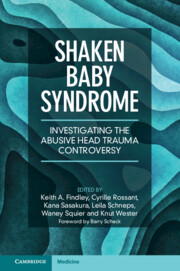Book contents
- Shaken Baby Syndrome
- Shaken Baby Syndrome
- Copyright page
- Dedication
- Contents
- Foreword
- About This Book
- Abbreviations
- Section 1 Prologue
- Section 2 Medicine
- Section 3 Science
- Chapter 10 The Swedish Systematic Literature Review on Suspected Traumatic Shaking (Shaken Baby Syndrome) and Its Aftermath
- Chapter 11 Interrogation and the Infanticide Suspect
- Chapter 12 Can Confession Substitute for Science in Shaken Baby Syndrome/Abusive Head Trauma?
- Chapter 13 Cognitive Bias in Medico-legal Judgments
- Chapter 14 Biomechanical Forensic Analysis of Shaking and Short-Fall Head Injury Mechanisms in Infants and Young Children
- Chapter 15 When Lack of Information Leads to Apparent Paradoxes and Wrong Conclusions
- Chapter 16 Epidemiology of Findings Claimed to Be Highly Specific for Shaken Baby Syndrome/Abusive Head Trauma, a Prerequisite to Improve Diagnosis of Child Abuse
- Chapter 17 Shaken Baby Syndrome
- Section 4 Law
- Section 5 International
- Section 6 Postface
- Appendix: Frequently Repeated Claims concerning Shaken Baby Syndrome
- Index
- Plate Section (PDF Only)
- References
Chapter 11 - Interrogation and the Infanticide Suspect
Mechanisms of Vulnerability to False Confession
from Section 3 - Science
Published online by Cambridge University Press: 07 June 2023
- Shaken Baby Syndrome
- Shaken Baby Syndrome
- Copyright page
- Dedication
- Contents
- Foreword
- About This Book
- Abbreviations
- Section 1 Prologue
- Section 2 Medicine
- Section 3 Science
- Chapter 10 The Swedish Systematic Literature Review on Suspected Traumatic Shaking (Shaken Baby Syndrome) and Its Aftermath
- Chapter 11 Interrogation and the Infanticide Suspect
- Chapter 12 Can Confession Substitute for Science in Shaken Baby Syndrome/Abusive Head Trauma?
- Chapter 13 Cognitive Bias in Medico-legal Judgments
- Chapter 14 Biomechanical Forensic Analysis of Shaking and Short-Fall Head Injury Mechanisms in Infants and Young Children
- Chapter 15 When Lack of Information Leads to Apparent Paradoxes and Wrong Conclusions
- Chapter 16 Epidemiology of Findings Claimed to Be Highly Specific for Shaken Baby Syndrome/Abusive Head Trauma, a Prerequisite to Improve Diagnosis of Child Abuse
- Chapter 17 Shaken Baby Syndrome
- Section 4 Law
- Section 5 International
- Section 6 Postface
- Appendix: Frequently Repeated Claims concerning Shaken Baby Syndrome
- Index
- Plate Section (PDF Only)
- References
Summary
Doctors and prosecutors who defend the diagnosis of shaken baby syndrome (SBS) point, among other things, to the many confessions obtained from parents and other caregivers as evidence of the reality of the diagnosis. Drawing on the existing social science research, this chapter examines the questions of (1) how, if at all, interrogations of those suspected of injuring or killing a child are conducted differently than other interrogations, and (2) what, if anything, would render such suspects more or less vulnerable to confession (true or false). The chapter examines how interrogations are typically conducted, and the primary reasons suspects confess, keeping in mind that their confessions can be either true or false. In the end, this chapter concludes that suspects in alleged shaken baby cases are arguably more vulnerable to false confession than those suspected of other crimes, and accordingly one cannot assume the reliability or truthfulness of confessions in these cases.
Keywords
- Type
- Chapter
- Information
- Shaken Baby SyndromeInvestigating the Abusive Head Trauma Controversy, pp. 179 - 188Publisher: Cambridge University PressPrint publication year: 2023

